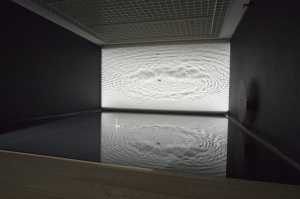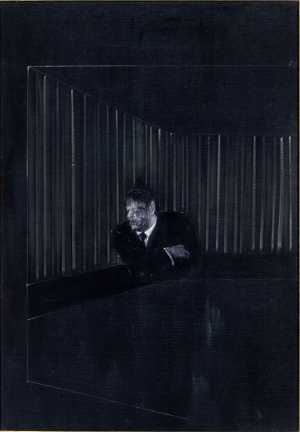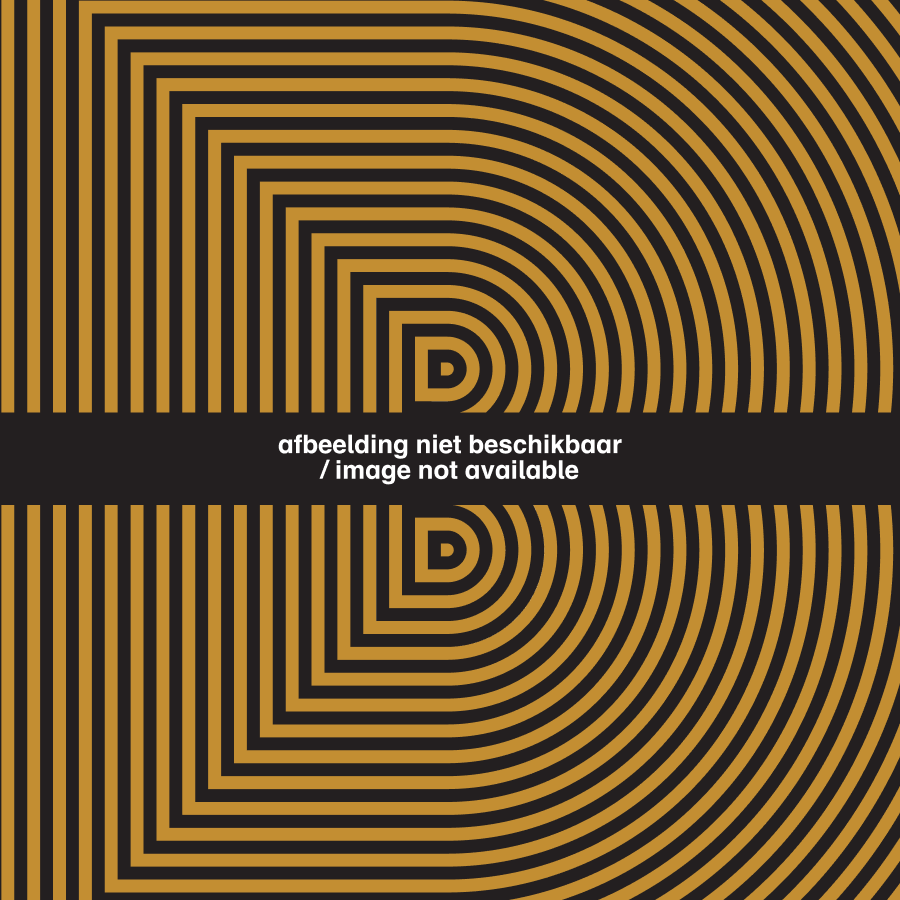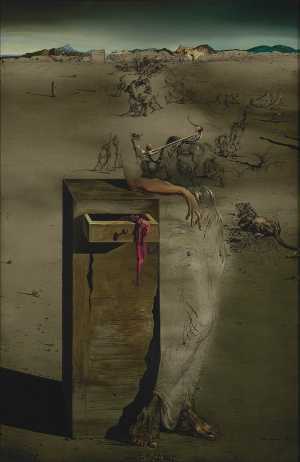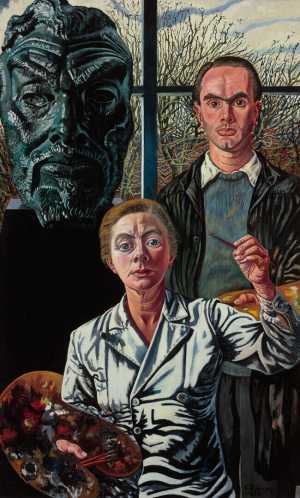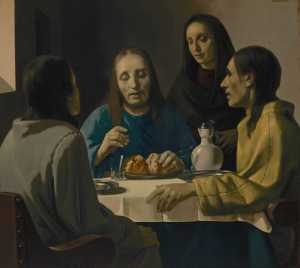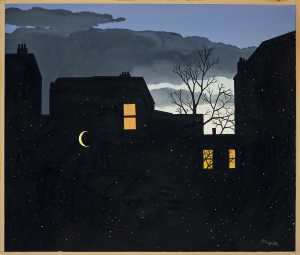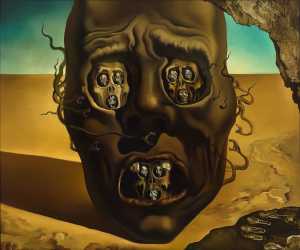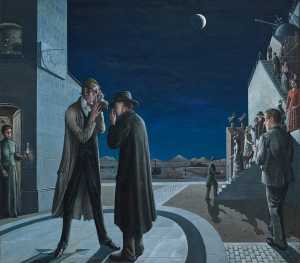Magritte loved confronting the viewer with an impossible image that looks deceptively real. The fence in this picture seems perfectly normal but those foot-boots most certainly do not. Their meaning is a mystery. A title usually helps with an incomprehensible scene. Not this time. 'The red model' - red? model? - just adds to the confusion.

Specifications
| Title | Le modèle rouge III |
|---|---|
| Material and technique | Oil on canvas |
| Object type |
Painting
> Painting
> Two-dimensional object
> Art object
|
| Location | This object is in storage |
| Dimensions |
Width 136 cm Height 183 cm Thickness 3,5 cm |
|---|---|
| Artists |
Painter:
René Magritte
|
| Accession number | 2992 (MK) |
| Credits | Purchased with the support of Stichting Museum Boijmans Van Beuningen, Rembrandt Association, Cultuurfonds, Erasmus Foundation, and Stichting Bevordering van Volkskracht, 1979 |
| Department | Modern Art |
| Acquisition date | 1979 |
| Creation date | in 1937 |
| Collector | Collector / Edward James |
| Provenance | Edward James, Chichester 1937-64; Edward James Foundation, Chichester 1964-79 |
| Exhibitions | Worthing/Eastbourne 1963-64; Paris 1972; London 1973a; Rotterdam 1996a; Brussels 1998; Los Angeles 2006-07; London/Rotterdam/Bilbao 2007-08; New York/Houston/Chicago 2013-14; Edinburgh/Hamburg/Rotterdam 2016-17 |
| Internal exhibitions |
Een prikkelcollectie (2000) The Collection Enriched (2011) Gek van surrealisme (2017) De collectie als tijdmachine (2017) |
| External exhibitions |
Magritte: The Mystery of the Ordinary 1926-1938 (2013) Surreal Encounters - Collecting the Marvellous (2016) Dal nulla al sogno (2018) Dalí, Ernst, Miró, Magritte... (2016) Dalí, Magritte, Man Ray and Surrealism. Highlights from Museum Boijmans Van Beuningen (2023) A Surreal Shock – Masterpieces from Museum Boijmans Van Beuningen (2021) Magritte, Broodthaers & de hedendaagse kunst (2017) Surrealist Art - Masterpieces from Museum Boijmans Van Beuningen (2021) Only the Marvelous is Beautiful (2022) A Surreal Shock. Masterpieces from Museum Boijmans Van Beuningen (2023) |
| Research |
Show research A dream collection - Surrealism in Museum Boijmans Van Beuningen |
| Literature | London 1973, p. 40, cat. no. 35; Sylvester 1992a, p. 244; Sylvester 1993a, p. 237, cat. no. 428; Brighton 1998, p. 26; Brussels 1998, p. 132; Rotterdam 2006, p. 78; London/Rotterdam/Bilbao 2007-08, pp. 274-75, cat. no. 11; Rotterdam 2007, pp. 112-13; Allmer 2009, pp. 10, 26, 38, 64, 183; New York/Houston/Chicago 2013-14, pp. 196-297, fig. 116; Edinburgh 2016, pp. 35, 200, 202, 216-17, 248, cat. no. 93 |
| Material | |
| Object | |
| Geographical origin | Belgium > Western Europe > Europe |
Entry catalogue A dream collection - Surrealism in Museum Boijmans Van Beuningen
Author: Marijke Peyser
On 28 January 1937 the eccentric English collector and patron Edward James invited René Magritte to spend two months in his house at 35 Wimpole Street in London.[1] This invitation was the precursor of an important commission for Magritte: making a triptych for James’s ballroom.[2] The three works were Le modèle rouge III, La jeunesse illustrée – both acquired by Museum Boijmans Van Beuningen from the Edward James Foundation in the second half of the 1970s – and Au seuil de la liberté (1937), now in The Art Institute of Chicago. Museum Boijmans Van Beuningen has a smaller, horizontal version of the latter work dating from 1930 (Au seuil de la liberté).
James corresponded with E.L.T. Mesens – the author, poet, publisher and art dealer –about the commercial aspect of the commission.[3] Few documents about the commission have so far come to light, so a number of important details are unknown – who suggested the subjects and dimensions, for instance, and where the paintings were to be placed. A crucial, but until recently overlooked detail, was the use of the French word panneaux – panels – instead of ‘paintings’ in the earliest correspondence between James and Magritte when they discussed the three works.[4] This suggests that they regarded the three works as an entity, a practice that goes back to traditional decorative wall coverings based on historical or mythological subjects made specifically for an interior.
The presence of these three paintings in James’s ballroom was confirmed by the British Surrealist and art collector Roland Penrose. He was a guest at the house in Wimpole Street during Magritte’s time in London and had seen them with his own eyes: ‘The paintings were set into the ballroom walls behind two-way mirrors so that they only became visible when lights behind the glass were switched on.’[5] After a soiree on 18 April 1937 James wrote enthusiastically to Magritte about his guests’ reactions to the works: ‘Your paintings produced a profound sensation at my ball. That evening, Youth Illustrated prompted many conversions to Surrealism among the British youth. But above all, the human boots struck a chord in the young dancing couples in their capitalist heels!’[6]
Le modèle rouge III is the left shutter of the triptych, with Au seuil de la liberté in the middle and La jeunesse illustrée on the right.[7] Magritte made three versions of Le modèle rouge.[8] In his lecture ‘La ligne de vie’ that he gave in the Royal Museum for Fine Arts in Antwerp in 1938, the artist said that the idea for the composition can be seen as the solution to a ‘problem’.[9] This ‘problem’ was the ‘monstrousness’ of habits and the unconcern that flowed from them. It was about ‘the ease with which a human foot could be placed in a leather shoe, the metamorphosis that then occurs, represented by the proximity of dead and living skin’.[10]
Footnotes
[1] See Sylvester 1993a, p. 5. In the end Magritte stayed for two weeks, see New York/Houston/Chicago 2013-14, pp. 195 and 208, note 7.
[2] To his regret Magritte did not get an exclusive contract with James, as the latter had signed one with Dalí, see no. 16.
[3] New York/Houston/Chicago 2013-14, p. 208, note 8: On 5 February 1937 James confirmed in a letter to Mesens that Magritte was to receive £250 for the commission. James supplied the necessary painting materials as Magritte had paid his own travel costs. See Sylvester 1993b, p. 51.
[4] See New York/Houston/Chicago 2013-14, p. 196.
[5] Sylvester 1993b, p. 53.
[6] New York/Houston/Chicago 2013-14, p. 199.
[7] See Rotterdam 2017, p. 175.
[8] The other versions are now in the Centre Pompidou, Paris and in the Moderna Museet, Stockholm.
[9] See Sylvester 1992b, pp. 205-07.
[10] Brussels 1997, p. 48.
All about the artist
René Magritte
Lessen 1898 - Schaarbeek 1967
René Magritte studied at the academy in Brussels. He began as pattern designer in a carpet factory and as painter by painting and designing advertising posters...
Bekijk het volledige profiel

